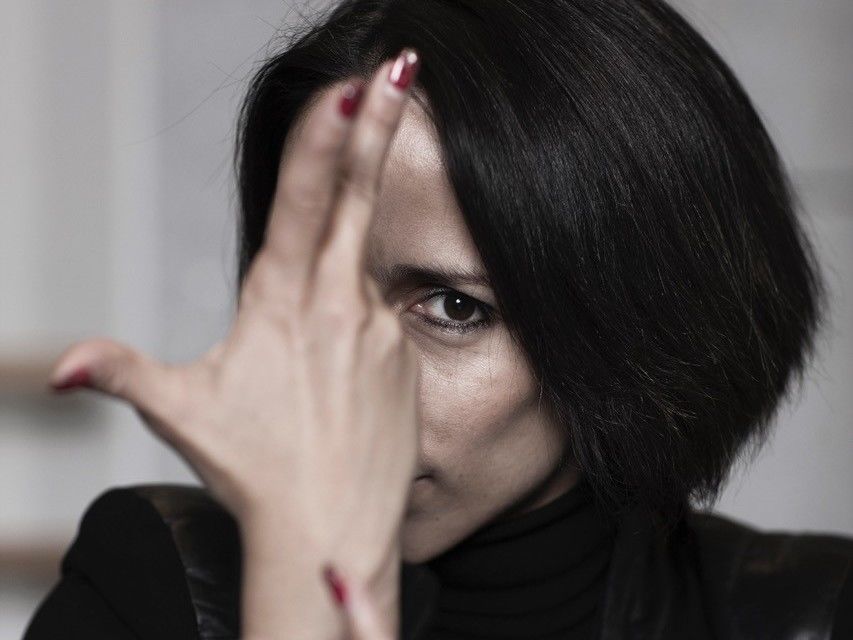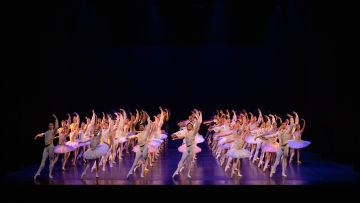Meet choreographer Annabelle Lopez Ochoa
Written by Cassandra Houghton
Photo by Rob Becker

On storytelling, ballet as escapism, and creating Coco Chanel: the Life of a Fashion Icon.
There was a moment during the ideation of Coco Chanel: the Life of a Fashion Icon when art and history aligned in perfect symmetry. Choreographer Annabelle Lopez Ochoa had been in Paris with costume and set designer Jérôme Kaplan, discussing fashion and staircases;
“I said from the beginning that I cannot do this ballet without staircases,” she recalls, smiling. “They are so iconic from all the historical pictures of the store at Rue Cambon, but also conceptually they refer to the ascension of Chanel throughout her life. Jérôme then had the idea to put two white spiralling staircases together and all of a sudden, we could see the ‘CC’ – it was beautiful.”
The play on Coco Chanel’s iconic logo is integral to the ballet’s story, which follows the French fashion designer through key moments of her controversial, yet fascinating life.
Speaking from the Dominican Republic one Sunday evening via Zoom, Annabelle says it was the story of the woman behind the perfume that drew her in.
“There are a lot of things we don’t know about Chanel - she was very complex. I felt that before one buys her perfume, one should know who this woman was,” she says.
“She’s the first businesswoman who built a fashion empire. She worked tirelessly until the age of 87. Her fashion was art, and on top of that, it helped to liberate women into more comfortable clothes. Still clothes made to seduce – Mademoiselle Chanel was a seductress, however she also gave women their freedom. She came from a time in the 1800s when you needed someone to help you get dressed. It was only the upper class that could afford that.
“I find it gratifying to present a ballet with a theme that enlightens us about the evolution of the position of women in society.”
Born in 1883, Chanel’s darkly ambitious life is steeped in controversy; her rise to fame throughout the World War II period and the poverty-stricken streets of occupied Paris, including her relationships with Nazi officials, has been well-documented.
Annabelle spent two years researching the French designer, resulting in a full-length narrative ballet that explores her life: both the bright and the dark elements of her character and career.
“She always lied about where and when she was born, because she didn’t want people to know about her modest beginnings after her father abandoned her and left her in a convent,” Annabelle says.
“At the beginning of her career she was sewing by day and singing in a cabaret by night, but even that wasn’t sufficient, and she felt forced to do other work and accept money from men in order to survive.
“And so, I tried to make it clear that during her entire life she fought for her independence, emotionally and financially.
“When she was a young business entrepreneur, she signed a contract that only left her earning 10 per cent of each perfume No5 that she sold. She fought her entire life to regain the rights over her perfume, in vain. Men abused the fact that she didn’t really know what she was getting into. The fragrance company is now worth billions of dollars because of this. It was fascinating to get to know more about her and to share it.”
Working closely with artistic collaborator Nancy Meckler, Annabelle says they decided to portray Chanel as a double character to symbolise the journey of her ascension.
“We have Chanel that starts at the bottom of the social ladder and becomes an icon and alongside her we have the Shadow Chanel, her inner drive. She never got married, never had children, she had hardships, successes, obstacles, and challenges, but it is her fate, her vocation in the form of the Shadow Chanel that pulls her up and pushes her through all the hardships. At the end of the ballet the two become one.”
The set design was inspired by Chanel No5’s classic ivory box; the costumes, of course, by her fashion. All the costumes evoke a quintessential Chanel quality and essence.
“I’m really grateful that what we had in our minds became a reality – it’s like a dream come true.”
Artistic ambition is a journey Annabelle can relate to. The acclaimed Belgian-Colombian choreographer completed her dance education at the Royal Ballet School of Antwerp, discovering a love of choreographing at 11 years of age. After dancing for 12 years in European dance companies, she left the stage to focus solely on choreography, and has created for 78 dance companies around the world. Since 2012, she choreographed 12 narrative ballets, including many inspired by strong, complex women from history, such as Frida for the Dutch National Ballet, Doña Perón for Ballet Hispanico and Callas, La divina for Municipal de Santiago. Choreography is the language (of which she can speak four) where she feels the most comfortable.
“I enjoy the poetry of ballet,” she says thoughtfully.
“When a work is too realistic, I doze off. Ballet is filled with heightened realism and heightened beauty. And these days, it is exactly what we need.
“What attracts me to choreography is that it moves people. I was watching the performance of BOTERO with my team, which we had created for Alberta Ballet, when suddenly, when the curtain came down, this woman seated in front of us turned around and showed her appreciation with tears. She couldn’t stop crying because she was so moved by the beauty of the dancing, the music, and the costumes. She made us promise that we would create another work together. And then you feel like, wow, I can move people with ballet. All the hard work we’ve done fills people with so much joy. We can share a bit of poetry and beauty in the world when it feels like it’s crumbling.”
The art of storytelling lies at the heart of her passion.
“I really believe in new stories. I think it’s time for the ballet world to make an effort and take risks. We are, unfortunately, primarily focused on ticket sales,” Annabelle says.
“But you know, we go to the movies to watch new stories that tell us something about humanity, so we should trust our audience that their curiosity will lead them to the ballet. It’s up to us to create good ballets, and this takes time and funding. The first time Swan Lake was presented in 1876, it was a failure…and look now, no one could imagine a ballet company without a Swan Lake in their repertoire. We need to look at the potential of a work of art, not focus solely on its shortcomings. The legacy I want to leave is that I have been fighting to bring new stories to ballet audiences.”
Book tickets to Coco Chanel: the Life of a Fashion Icon below.



